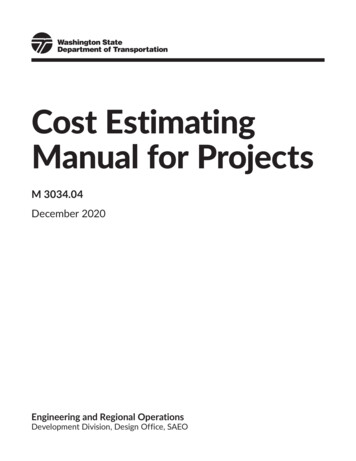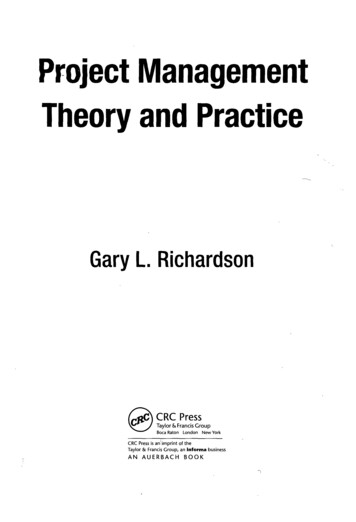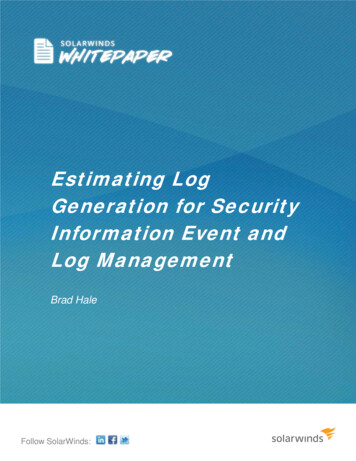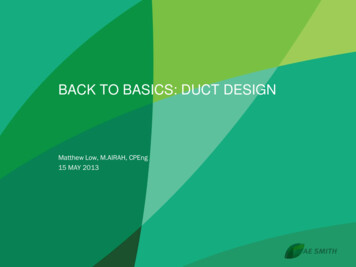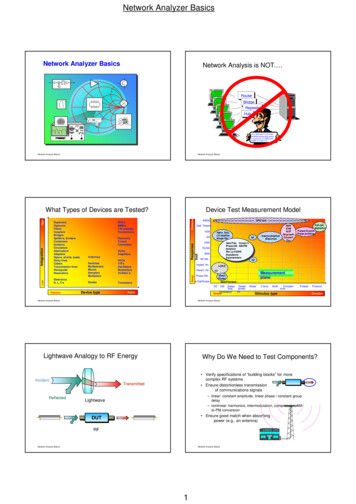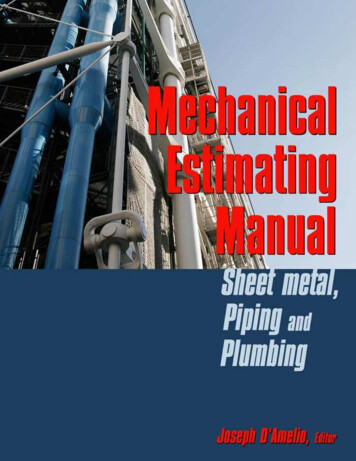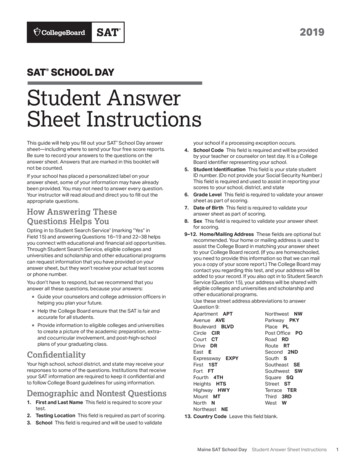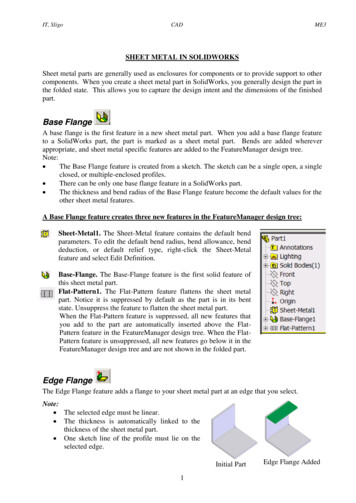
Transcription
BACK TO BASICSESTIMATING SHEET METALFABRICATION COSTSA Step-By-Step Guideto UnderstandingHow Fabricated PartsAre EstimatedBrought to you by . . . .
UNDERSTANDING SHEET METAL COSTSIS THIS EBOOK RIGHT FOR ME?Not quite sure if this ebook is right for you? See the below description to determine ifyour level matches the content you are about to read. INTRODUCTORYIntroductory content is for practitioners who are new to the subject. This content typicallyincludes step-by-step instructions on how to get started with estimating sheet metal parts.After reading it, you will be able to execute basic cost models with your supply chain. INTERMEDIATEIntermediate content is for leaders who are familiar with the subject but have only basicexperience in executing strategies and tactics on the topic. This content typically covers thefundamentals and moves on to reveal more complex functions and examples. After reading it,you will feel comfortable building cost models for all your metal parts. ADVANCEDAdvanced content is for leaders who are, or want to be, experts on the subject. In it, we walkyou through advanced features of global metal part sourcing and help you develop completemastery of the subject. After reading it, you will feel ready not only to execute strategies andtactics, but also to teach others how to be successful.Follow us on .Http://www.ETMmfg.com2
UNDERSTANDING SHEET METAL COSTSETM MANUFACTURING’SSHEET METAL SOLUTIONS . brings technologyinnovation to leanmanufacturing- Reduce time to market- Eliminate redundancy- Improve flexibility- Lower total costsCOST ILIZATIONFollow us on .Http://www.ETMmfg.com3
UNDERSTANDING SHEET METAL COSTSESTIMATING SHEET METALFABRICATED PARTSby Rob OlneyRob is president of ETM Manufacturingand has been applying the principles ofopen book management since his firstday on the job.Previously, Rob was the Director ofSourcing and Product Development atStaples where he worked on 100 newproduct launches with 50 supplierslocated around the world.FOLLOW ME ON TWITTER@ETMMFGRob is passionate about helping improvecustomers’ competitiveness as a key tokeeping jobs local and improving ourcommunities. He blogs regularly aboutcontrolling product costs and the supplychain at www.ETMmfg/blog.Follow us on .Http://www.ETMmfg.com4
UNDERSTANDING SHEET METAL COSTSContentsIntroduction: How to Understand Your Suppliers’ QuoteChapter 1 Understanding Material CostsChapter 2 Determining True Labor CostsChapter 3 The Big 5.Overhead CostsChapter 4 Beware of the Freight TaxConclusion Using Supplier Profit to Your AdvantageFollow us on .Http://www.ETMmfg.com5
Why should you care aboutyour suppliers’ costs?Let’s face it, we all have too much to do with too little time. With the time wehave available, most is spent in meetings or troubleshooting issues. Why does ithelp to understand sheet metal fabrication costs? We have found that some ofthe meetings and issues can be avoided once we understand the drivers behindsheet metal fabrication costs. Lot charges can be avoided if order quantities varyslightly. Non-recurring engineering (NRE) charges can be minimized with smalldeviations from the drawing. Lead times can be shortened once material gradesare taken into consideration. The more we know about fabrication costs, the morewe can provide lower cost designs.In some cases, we have strategic sources that are valuable to the project, yetadditional costs savings are required. Working together with our suppliers, we canidentify areas that have the biggest effect on costs and go to work as a supplychain team to reduce lead times and lower costs. Transportation costs betweencompanies and inside each company can be as much as 50% of the product costsand lead time. Once costs are understood throughout the supply chain, new waysof coordinating work can be developed that save everyone time and money.These changes can be implemented on one project, then easily transferredbetween projects.Our mission is to help our customers improve their competitiveness. Sometimesthis is a lower piece price, but often it involves solving long established supplychain redundancies to uncover deep savings and significant lead time reductions.Understanding Total Costs Leads to Big Savings3/4/20146
UNDERSTANDING SHEET METAL COSTSOur experience has shown us that byworking together, we can challengelong held assumptions about how anassembly is designed as well as how it ismanufactured.One customer came to ETM to helpreduce costs by 10%. We took one lookat the design and new we could saveeven more by redesigning the assemblyto eliminate parts. The end result wasfewer parts, but also less assembly timeand improve ease of use.Another customer needed help meetingtheir cost target. After reviewing thetotal costs of the assembly, we noticedthat almost 20% of the part cost wastransportation. Instead of shippingheavy metal parts to the contractassembler, the customer re-configuredthe supply chain to ship the lighterparts to ETM, where we assembled theunit, and then shipped directly to theircustomer from ETM.Every day we share our sheet metalestimating knowledge with ourcustomers so we all make informeddecisions to improve competitivenesstogether. We believe ETM can be acompetitive weapon instead of areluctant cost on your bill of materials.Follow us on .Http://www.ETMmfg.com7
UNDERSTANDING SHEET METAL COSTSJust How are Sheet MetalFabrications Estimated?Most original equipment manufacturers (OEMs) request quotes from two to fivesuppliers for their sheet metal fabrication requirements. Pricing between suppliers candiffer by as much as 50%. Why does the pricing fluctuate so much? More importantly,will sourcing to the lowest cost supplier really cost the company the least?Understanding the costs of a sheet metal part will help you evaluate the choices eachsupplier is making to provide their price.First, let’s take a look at some of the key components of a sheet metal fabrication quote.Typically they include four important areas: materials, labor, services and overhead. Youwill see in this eBook that costs can be transferred between categories depending on thecost, quality and lead time targets required for the project. MaterialsIn this case, the materials included in this category are raw materials like sheet stock, barstock and rod stock. Most sheet metal fabricators also include purchased materials suchas hardware, gasketing, other components purchased for the product that is shipped tothe customer. Some might include packaging, particularly unique packaging, in thematerials category although most include packaging materials in the overhead category.Other materials such as punch tooling or press brake tooling as well as general shopsupplies like oils, towels, and coolant are typically categorized as overhead costs.One “hidden” materials cost is the in-bound freight costs. Sometimes this cost isincluded in the price of the material. In other cases, it is added as an additional cost onthe invoice, but the buyer is never aware of the costs. In other cases, the material isshipped in on our account and shows up in a monthly bill. When all of these costs areFollow us on .Http://www.ETMmfg.com8
UNDERSTANDING SHEET METAL COSTSclear each cost is assigned to the product cost. If the “hidden” costs are not clear, thenthe costs are spread over the entire customer base or a portion of the customer base.Depending on the effectiveness of the sheet metal fabricator’s accounting system, youcould be paying more (or less) than your fair share of these in-bound freight costs. LaborThere are several ways to look at the labor category. Direct labor is the labor costassigned to make the products. Indirect labor is the cost assigned to run the business.Every supplier needs both types of cost and every supplier may take a slightly differentapproach to what labor cost is assigned to each category. For example, one companymight assign engineering labor as a direct (part) cost and another supplier might assignengineering labor as an in-direct (overhead) cost. Here again, depending on how eachsupplier assigns these costs in their accounting system, you could be paying more (orless) for your fair share of indirect costs.Here is a simple example to illustrate the point:Supplier ASupplier BMaterials 100.00 100.00Direct Labor 100.00 100.00Engineering 100.00 (direct)20%(indirect)Total 300.00 240.00In this case, Supplier B will provide a lower price than Supplier A only because SupplierB chose engineering to be an indirect cost using a 20% charge across all products.Supplier A might have a more accurate cost, but higher. Note that the oppositeoutcome will result on a less complex part where the direct engineering cost is 20.Follow us on .Http://www.ETMmfg.com9
UNDERSTANDING SHEET METAL COSTSThe point here is that “accurate” costs are not always the “right” costs in the eyes ofthe customer. Sometimes pricing differences like the one in the example can beevened out in services costs or overhead costs. ServicesIn most product companies, there is a decision to be made on whether to “make” or“buy” a particular component. Sheet metal fabricators also have these same choices.The most significant choice involves coatings such as plating or powder coating. Inmany cases, the cost of the equipment is simply too much given the small amount ofcustomer requirements for the coating. In other cases, the EPA requirements or theplant space required for the coatings makes in-house coating difficult. In these cases,the choice is to source the service from an outside company. When these services areoutsourced, the piece price is assigned directly to the sheet metal fabrication quote.There are also hidden costs in out-sourcing services. In most cases there aretransportation costs to the service provider and back again. Sometimes these costs aredisclosed and easily assigned to the product. In other cases orders are grouped,making it difficult to accurately assign to each sheet metal fabrication. There are alsoa wide variety of fees depending on the supplier: lot charges, set-up fees, hazardoushandling fees, storage rental fees, rare material surcharges, handling fees, packagingfees, sales taxes and financing fees can all be hidden or spelled out by the serviceprovider. In most cases, these fees are part of a mark-up that is added on the servicecost.In some cases, it makes sense to “make” the service in-house. In that case, materials,labor, overhead are all separated into categories. Often this is assumed that the inhouse costs are lower. Certainly the transportation costs are lower. Sometimes thecoating costs are lower, but it will depend on the switch-over cost, the queue time andthe idle time involved in the product mix of the sheet metal supplier. OverheadOverhead, also called SG&A (Sales, General & Administrative), costs are the costsrequired to run the business. Typically these are spread out over every item shippedequally as a percentage of the cost of the product. The “Big 5” overhead costsFollow us on .Http://www.ETMmfg.com10
UNDERSTANDING SHEET METAL COSTSfor a sheet metal fabricator are:1.2.3.4.5.Office wagesSales wagesPayroll taxesEmployee health careRentThere are certainly other costs that are significant like marketing expenses, equipmentmaintenance, building repair, insurances, legal and accounting services as well astraining expenses, but these grow (or shrink) with the business and work well whencovered as a percentage of product cost.According to the latest data from Financial Research Associates for Sheet MetalFabricators with assets under 2M, the following costs were reported:General/Administrative CostsOfficer/Exec wagesSales Wages & Other*Payroll taxes (20% of labor)Insurance (health, property, etc.)Rent27.23%8.63%6.85%5.08%3.71%2.96%*not reported, calculatedThe Big 5 expenses don’t change as much as the business grows or shrinks. As a result,a sheet metal fabricator may have a certain “fixed” overhead costs that need to be paidregardless of the sales. Most sheet metal fabricators use a sales target and calculatethe overhead percentage to cover the expenses and once the sales target is achieved,the overhead costs are covered. As we will discuss later, this can be helpful to know inyour strategic sourcing decisions.Follow us on .Http://www.ETMmfg.com11
UNDERSTANDING SHEET METAL COSTSWhere to Gather DataNow that we’ve covered the basic components of sheet metal fabrication costs, it is importantto understand the regional effects on costs. Material costs are lower nearer to the source.Labor costs fluctuate due to demand and skill level. Overhead costs – particularly health carecosts – change dependent on the age of the employee population. The good news is thatmuch of this information is available to you for free.In this ebook, we will walk you through the process of locating the sources of the informationavailable, building a cost model from this information and then evaluating the impact of yoursourcing decisions based on this information.From your local library and several important web-sites, there are some key costing data tohelp complete an accurate costing model. These include: Raw material costs, plus conversion costs for sheet, bar and rod stockComponent and hardware costsHourly labor rates for all key sheet metal positions including some overhead dataService cost calculators to estimate outside servicesHealthcare cost estimatesDetermining rent rates based on location and building agePayroll calculations and tax estimationDetermining sales costsEach chapter will go into greater detail to help you understand the costs, the assumptions andthe impact on your sourcing decisions. Now let’s get started!Follow us on .Http://www.ETMmfg.com12
ProfitOverheadServicePartCostMaterialLabor
CHAPTER 1UNDERSTANDINGMATERIAL COSTS
UNDERSTANDING SHEET METAL COSTSIt All Starts with Your Lay-flat DimensionsEvery sheet metal fabrication starts with the sheet stock. To determine thesheet stock size, we start with the lay-flat. The lay-flat is the footprint of thepart as it is unfolded and laid flat on the sheet stock. Take for instance, a fivesided cube, 2” square. When you unfold it, the material is shaped like across, occupying a 6”x 6” inch piece of sheet stock.6”2”2”8”6”This part lay-flat will now need to punched or laser cut from a sheet ofmaterial. What is the most efficient way to use the material? That dependson the part lay-flat.All sheet stock is extruded at the mills, slit into 8’ or 10’ widths and thenrolled into coils for transport. At distribution, the coils are flattened and cutinto 3’ or 4’ widths. As a result, sheet stock typically comes in 3’ x 8’ sheets,4’ x 8’ sheets or 4’ x 10’ sheets. Allowing for a 2” tool clearance betweenparts, the yield of this part would be 48 pieces per 3’ x 8’ sheet, or 72 piecesper 4’ x 8’ sheet, or 90 pieces per 4’ x 10’ sheet. In the example above, the8” footprint does not divide equally in a 3’ wide sheet, so it will be more costeffective to use a 4’ wide sheet.Follow us on .Http://www.ETMmfg.com15
UNDERSTANDING SHEET METAL COSTSCarbon Steel CostsMost raw material costs are listed by the London Metal Exchange (LME). These pricesare commodity prices listed on the day of trading. To convert these spot prices to pricepaid by the sheet metal fabricator, first go back 30 days from today to when yourmaterial was purchased, then add a 20% conversion fee (raw ingot to sheet stockdelivered to your fabricator). This will provide fairly accurate pricing. For example,current coiled rolled steel pricing from several distributors is 0.54/lb. Go back a monthto get the spot price of 0.45/lb, multiply by 1.2 to get today’s current price of 0.54/lb.Source: low us on .Http://www.ETMmfg.com16
UNDERSTANDING SHEET METAL COSTSAluminum CostsAs you can see from the chart below, aluminum pricing varies considerably based onsupply and demand. Last month’s spot price is considerably different from this month’sspot price. For large orders, sheet metal fabricators check pricing with theirdistributors. On small orders, most sheet metal fabricators use an average so that theirprice doesn’t fluctuate too much for their customers. For aluminum, the conversion rateis about 1.8, so an LME price of 1.00/lb is about 1.80/lb from distribution.Source: https://www.yarde.com/documents/aluminum.pdfWhy not buy and hold? Just like your stock portfolio, it is very difficult to pick the lowpoint for any given commodity. Weekly orders of similar size does that same as “dollarcost averaging” does for your portfolio. Although prices can fluctuate by 20%, buyinglow and holding ties up precious cash for the low-margin sheet metal fabricator.Follow us on .Http://www.ETMmfg.com17
UNDERSTANDING SHEET METAL COSTSStainless Steel CostsStainless pricing is harder to pinpoint only because several grades are used by sheetmetal fabricators and several raw materials are used to create stainless steel alloys.There are several options for types of stainless as well as material formats. We use aconversion rate of 1.5 for stainless steel, but this can vary greatly based on materialgrade, finish and availability. Here is an historical example for 304 stainless:Source: www.metalprices.com.Follow us on .Http://www.ETMmfg.com18
UNDERSTANDING SHEET METAL COSTSCalculating Material Costs per PartA common mistake made in calculating the material cost of a part is to take theweight of the part and multiply by the cost per pound of the material. In sheetmetal fabrication, an entire sheet is ordered to make the parts. Material costsmust include the extra material not used in the part, but included in the sheet. Determine Your Sheet Stock CostA simple call to your local material distributor will help you determine the sheetstock price. Sometimes, volume purchases do lower the price. Other times,prices are lower if the material is in stock. Keep in mind the material price youare paying for now was actually purchased by the distributor almost 30 days ago!This is particularly important in inflationary (or deflationary) times. Use Your Lay-flat To Calculate Sheet YieldTake the part you are estimating and unfold it in your mind to have it lay flat onthe sheet stock. Use your longest and widest dimension to establish a foot print.Add a 2” border to allow for tooling clearances. Plan out the footprint on the 3different sizes of sheet stock to determine the best yield. Then, divide the sheetcost by the yield to get the true material cost per part.One note about scrap costs. Unused material (aka scrap) is collected and sold torecycling companies. Typically scrap pricing is about 10% of the virgin material.So for example, if the sheet stock cost was 20/sheet, and there was 20% scrap,then that means 4 of virgin material was not used, with a total scrap value of 0.40. We then add the labor cost to move the scrap sheet to a pallet ( 0.20),then the labor to load the scrap truck ( 0.05), then the carrying cost of thematerial ( 0.12) and total costs are 0.37 for a net profit of 0.03 per sheet onthe scrap material.There are exceptions. Sometimes the part creates an awkward lay-flat which inturn creates excessive scrap which needs to be included in your part cost. Othertimes, the cost to nest parts together can be recouped by the scrap savings.Follow us on .Http://www.ETMmfg.com19
GET GREAT MATERIAL PRICINGEVERY TIMEWe provide industry bestpricing for cold rolled steel andaluminum sheet stock to giveyou the competitive advantageyou need. Lay-flats areoptimized for maximummaterial yield to lower cost andimprove throughput. Volumediscounts for hardware.Learn the latest raw material pricing and itseffect on part costsEasily compare the engineering costs to nestparts versus the scrap cost without nestingUse ETM material calculators to betterunderstand the cost of your material choicesRequest a QuoteRead More
UNDERSTANDING SHEET METAL COSTSHardware Material CostsThe most common sheet metal hardware are PEM hardware designed by PENNEngineering (http://www.pemnet.com/) and distributed in New England by DBRoberts (http://www.dbroberts.com/). Almost every sheet metal fabricator in theregion buys from the same distributor at very similar pricing. The actual costs arevery small relative to the cost a sheet metal part. Here are some examples:Nuts with load bearing threads forsheet metal. Price varies from 0.05/pp to 0.15/pp depending onsize and length.Blind threaded fasteners for sheetmetal. Price varies from 0.10/pp to 0.35/pp depending on size andlength.Flush head threaded stand-offs forsheet metal. Price varies from 0.05/pp to 0.35/pp depending onsize and length.Blind threaded standoffs for sheetmetal. Price varies from 0.05/pp to 0.35/pp depending on size andlength.Follow us on .21Http://www.ETMmfg.com
Addto Cart1PENNEach1/101/17/14CLS-632PEMCLS br fon229,733ENUNDERSTANDING SHEET METAL COSTSSpecific Hardware CostsMost hardware costs are sheet metal specific hardware, designed predominatelyby the PENN Engineering group. This hardware is commonly called “PEMfasteners.” The only regional distributor for PEM hasteners is DB Roberts whichcontrols the price of hardware for all sheet metal fabricators in New England.Typically no special pricing is provided except for volumes breaks, so there is littleprice advantage based on who your supplier is. Larger suppliers may have more inhouse inventory which may help.Here is an example of PEM Fastener hardware pricing from their eStore:Follow us on .Http://www.ETMmfg.com22
UNDERSTANDING SHEET METAL COSTSFinishing CostsUnlike sheet metal hardware costs being controlled by one distributor in the region,painting and plating services vary greatly based on quality, speed, part size andquantity. Here are some examples:Zinc Plating (for steel) to protect against rust.Shown here in clear zinc and yellow zinc.Pricing is typically 0.20 - 0.25 per sq. in.Anodize Plating (for aluminum) to protectagainst oxidation. Shown here in black andclear although many colors are possible.Pricing is typically 0.24 - 0.27 per sq. in.Chromate Plating (for steel) to protectagainst rust. Shown here in clear chromateand yellow chromate. Pricing is typicallyabout 0.20 per sq. in.Powder Coating (for steel and aluminum) toprotect and add color. Most colors andtextures available. Pricing varies widely;however, pricing is typically 0.20 - 0.25 persq. in.Follow us on .Http://www.ETMmfg.com23
UNDERSTANDING SHEET METAL COSTSPackaging CostsSmaller sheet metal fabricators are more likely to re-use their in-bound rawmaterial packaging to ship product to their customers. It may not look uniform orpretty, but it saves you 2 - 4 per box. This can add up if your part is unusuallyshaped. Pallets can also be re-used; however, strapping cannot. Depending on thesize and weight of your parts, 2 plastic straps ( 1.50) would work or 8 steel straps( 2.00) might be needed.Larger sheet metal shops receive more incoming freight on pallets and less inboxes. There just aren’t enough boxes to re-use. As a result, boxes and packaginginside the boxes is purchased. Wrapping paper, bubble wrap, and tape also adds toyour piece part costs. Progressive supply chains work on re-usable containers toavoid the extra packaging cost (and waste).Using re-usable packaging signals your supplier to fill up just like your waitress fillsup your empty coffee cup. No more, no less – just the right amount.Follow us on .Http://www.ETMmfg.com24
UNDERSTANDING SHEET METAL COSTSConsigned MaterialsConsigned materials are purchased by the OEM and shipped directly to the sheetmetal fabricator. Sometimes OEMs with multiple suppliers can get better pricingdirectly with a mill. Sometimes the material risk is too high for the sheet metalfabricator (rare or shelf-life limited) and the OEM is required to purchase thematerial. Other times the OEM provides “left over” material from another source.While the cost advantages may be clear, there are issues to watch out for. On theOEM side, realize you are paying for material for your product and the associatedscrap. Under supply your fabricator and you run the risk of a very expensive end run.Sometimes there are unexpected handling and/or inventory costs. Work with yoursupplier to understand the total cost savings (lower material and higher handlingcosts may be zero-cost advantage).Consigned materials do not mean no material costs. Your sheet metal supplier stillneeds to receive the material, move it, store it, protect it and inventory it until readyfor use. Typically sheet metal suppliers add a mark-up percent to cover this costwhich may or may not work to your advantage.Follow us on .Http://www.ETMmfg.com25
CHAPTER 2DETERMINING TRUELABOR COSTS
UNDERSTANDING SHEET METAL COSTS“Hourly rate is just one part of the labor equation”When we look at sheet metal fabrication labor rates, the first thing we consider is thehourly rate. Typically the hourly rate for more complex work centers are higher thanless complex work centers. In addition to hourly rate, equipment costs, energy costs,and floor space requirements all roll up to the “shop rate” of a particular work center.Here is a simplified example for a sheet metal mechanic fully loaded direct hourly rate.Cost ComponentRateLabor Rate 20/hrTime Off Allowance 1/hrPayroll Taxes 5/hrHealth Benefit 4/hrInsurances 5/hrEquipment 6/hrMaintenance 2/hrSupplies 2/hrUtilities 2/hrFloor Space 1/hrTotal Direct “Labor” Costs 48/hrAssume 80% Efficiency 60/hrNote - Keep in mind that some of these costs vary with the labor rate and other costsvary with the equipment.Follow us on .Http://www.ETMmfg.com27
UNDERSTANDING SHEET METAL COSTSUnderstanding WorkflowPrior to calculating the total labor costs of your part, we need to understand the workflow for the particular part. Here is the typical work flow for a sheet metal fabrication:Programming: If a solid model is provided,programming time is saved.ProgrammingPiercing: Depending on the part, punching orlaser cutting is more appropriate for the part.Laser/PunchDeburr: Also known as “timesaving” and canvary considerably depending on cosmetics.DeburrForm: Sometimes an extra tooling chargesaves considerable forming time.FormWeld: Spot welding saves time over seamwelding (MIG or TIG).WeldGrindShippingGrind: A better weld (aka more expensive)can save grinding time.Shipping: More packaging time is needed ifcosmetics are important.Follow us on .Http://www.ETMmfg.com28
UNDERSTANDING SHEET METAL COSTSProgramming Labor CostsAny fabricated part that is new to your fabricator will need to be programed for themachines running in the shop. Two important variables in the programing costs arepart complexity and programming queue time. Most programming costs involve laborand software.Typical CNC Machine programmerEmployee benefits (health, payroll tax)Solidworks site licenseCNC Equipment software licenseTrainingAnnual Hardware improvementsTotal Annual CostsAssuming 1,600 hrs billedTypical pricing with SG&A 75,000 25,000 5,000 5,000 5,000 1,000----------- 116,000 72.50/hr 90 - 100/hrIt is important to remember that this cost does not assume that 100% of theengineer’s working time is billable to production. In most cases, a constant flow ofexactly the right amount of programming does not happen. Instead the workfluctuates from a few small jobs to a large package that take a whole week to program.And, unlike a production worker that may be use to fluctuating work hours, a CNCmachine programmer expects to be paid for 40 hours regardless of the demand; anyless and you risk losing a great programmer.Sometimes spending more in programming will save you more over the life of theproduct. The most expensive parts to program are reverse-engineered projects. Inthis case, programing costs include disassembling the unit, measuring each part,creating a 3D model and then creating the CNC laser or CNC punching program. Thistakes longer, so it will cost more; however, if the scope of work is well defined, severalcost savings opportunities can be identified and implemented.Follow us on .Http://www.ETMmfg.com29
UNDERSTANDING SHEET METAL COSTSLaser Labor CostsThe great appeal of laser cutting is the lack of set-up time. For most sheet metal partgeometries, and most material thicknesses, laser cutting is the method of choice forlow-volume, high-mix production. Programming is done off-line, so set up is typicallyless than 15 minutes. Here is a typical breakdown:Typical CNC Machine operatorEquipment DepreciationRent, 100 SFLaser GasMaintenanceElectricityAssuming 1,600 hrs billedTypical pricing with SG&A 60/hr 34/hr 4/hr 1/hr 2/hr 1/hr----------- 102/hr 110 - 120/hrThe key to laser cutting is a fast cut. Newer machines have faster cut times which iswhy equipment depreciation is included in the costs. A fully depreciated laser has alower rate, but a slower cut. After about 5,000 hours (approximately 2.5 years) theresonator needs to be re-built, which keeps the equipment costs high. Oxygen ornitrogen gas helps with a faster, cleaner cut, but the costs breakeven with the fastercut time.How can you keep your laser cost down? Help with making it easy to cut. Sharpcorners make the laser head re-orient, causing a slight pause. Holes add pierce timewhich slows the cut time. Thick material, especially stainless steel, will slow the lasercut down. The least expensive laser part has sweeping curves and no holes.A good sheet metal fabricator will spend more on the programming to save time onthe laser (spend 100/hr to save 120/hr). Set-up time can be reduced further if thefabricator has enough product mix to run parts with similar mate
sheet metal fabrication costs. Lot charges can be avoided if order quantities vary slightly. Non-recurring engineering (NRE) charges can be minimized with small deviations from the drawing. Lead times can be shortened once material grades are taken into consideration. The more we know about fabricati

